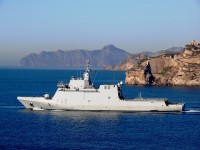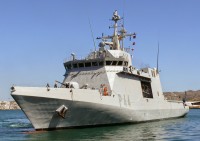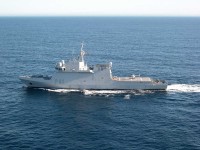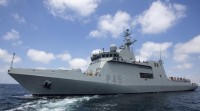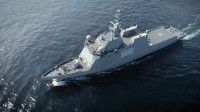Оффшорные патрульные корабли типа Meteoro
Основная информация
Главные размерения
Машина
- 2 * diesel engines
- 4 * groups diesel generators
- 2 * electric motors propellers
- 1 * Emergency generator
- Located 2 cross bow thruster
Персонал
Боевые силы и средства
- 1 * OTO Melara 76 mm
- 2 * 25 mm automatic mountings Mk-38 MOD 2A
- 2 * 12.7 mm machine guns M2 Browning
- 4 * Mark 36 SRBOC
- 1 * Agusta-Bell 212
The Meteoro-class offshore patrol vessel, also known as Buque de Acción Marítima (BAM), are new modular offshore patrol vessels of the Spanish Navy adapted to different purposes from a common base, manufactured by Navantia. The BAMs combine high performance with mission versatility, a high commonality with other ships operated by the Spanish Navy. Acquisition and lifecycle costs are reduced.
The Meteoro-class offshore patrol vessel are a common platform for a variety of missions, used to develop whole families of types of ships that meet the diverse needs of the Navy.
Its main missions are:
- Protection and escort of other ships in low intensity/asymmetric warfare situations
- Control of maritime traffic
- Control and neutralization of terrorism and piracy
- Operations against drug trafficking and human trafficking
- Search and rescue
- Support for crisis situations and humanitarian aid
- Control of fishing laws
- Control of environmental legislation and anti-pollution.
Modular design enables the ships to be modified for purposes outside main missions such as hydrographic research, intelligence gathering, diving support and salvage operations.
Construction began on 4 October 2007 with the cutting of the first sheet and was placed on the stands the first on 13 March 2009, in the shipyard San Fernando. The budget was €352m but the final cost was €488.4m for four units (~US$160m each).
In June 2009, the Secretary of State for Defence and Congress confirmed the construction of a second batch to replace older patrol boats of the Anaga (3), Toralla (2), Descubierta (4) and the now-retired Barceló (6) and Conejera (4) classes. In September 2010, the Ministry of Defence said a contract would be signed with Navantia for four additional vessels to be delivered by 2015, but the contract has yet to be signed. Navantia has indicated that the Batch 2 vessels will be more modular, with the potential to switch between oceanography, intelligence gathering and search-and-rescue. One will be a diving support vessel, and one will be a research vessel for hydrography and logistical support in the Antarctic. The acquisition of two vessels, to enter service in 2019, was formally approved by the Spanish cabinet on 18 July 2014 at a cost of €166.74m (US$224m) each.
Корабли6
- Комментарии
 ru
ru en
en uk
uk
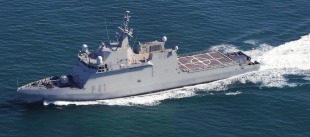


 Военно-морские силы Испании
Военно-морские силы Испании